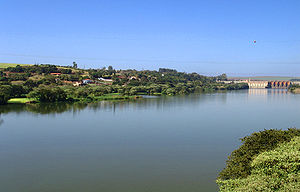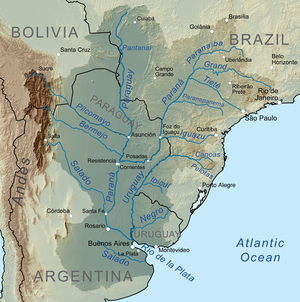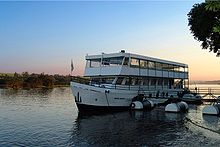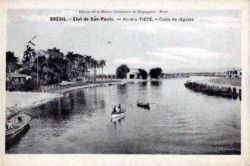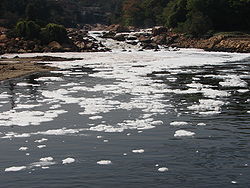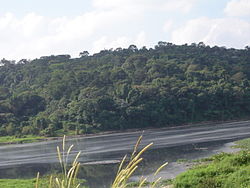- Tietê River
-
Tietê River Country Brazil Region South America Source Salesópolis, Serra do Mar Mouth Lake at the Eng Souza Dias (Jupiá) Dam, Paraná River Length 1,150 km (715 mi) The Tietê River (Portuguese, Rio Tietê)[1] is a Brazilian river in the state of São Paulo.
The source is in Salesópolis in the Serra do Mar, at 1,120 m altitude. Although the source is at most 22 kilometres (14 mi) from the coast, the escarpment of the Serra do Mar forces it to run in the opposite direction, to the interior, going through the state of São Paulo from southeast to northwest till it runs into the artificial lake formed by Eng Souza Dias (Jupiá) Dam on the Paraná River, in the municipality of Três Lagoas, about 50 kilometres (31 mi) from the city of Pereira Barreto.
The name Tietê was registered for the first time on a map published in 1748 by d’Anville.[2] The name signifies "The truthful river", or "truthful waters"[3] in Tupi.
Contents
Sources of the Tietê River
A “set of sources” make up the "Park of the sources of the Tietê River,"[clarification needed] which is situated in the municipality of Salesópolis. It is an area of about 134 hectares, of which 9,6 ha already is under environmental control. This park protects the varying sources of the river and will certainly form the most important protected area of the state of São Paulo.[clarification needed]
Initially, when the park was in the hands of private persons, the original flora were destroyed. When the property rights fell to the State, its area was recuperated and is now presenting secondary forest again. A local mural provides some data of the sources of the Tietê River. As these data indicate, one may verify that a source produces more than 3 cubic metres per hour (0.029 cu ft/s) of water. Along the length of its initial stretch, the Tietê River receives additional water from various small streams, turning into a current with an elevated volume of water, in the short distance it has run.
On entering the municipality of Salesópolis, it encounters one of the first hydroelectric power stations constructed in Brazil, which is the actual "Usina Parque de Salesópolis" ("park of Salesópolis" Factory), Constructed in 1912 by the old São Paulo Tramway, Light and Power Company, it generated energy from an artificial waterfall with a height of 72 m of the river. The park is open for public visits, and there is a museum next to the factory. From 2008 the production of electric energy has been resumed.
Area of influence
The Tietê River runs through the metropolitan area of São Paulo City and runs through 1,136 kilometres (706 mi) of the interior of the São Paulo state, up to the municipality of Itapura, into its mouth, the Paraná River, at the border with Mato Grosso do Sul.
Within the city of São Paulo, it runs next to the express highway Marginal Tietê, which, together with the Marginal Pinheiros, makes up the principal road system of the city. It is estimated that 2,000,000 vehicles pass through either one of the two “marginals” per day CET Company for Traffic Engineering.
Not far after leaving the city of São Paulo, the Tietê River turns to the municipality of Santana de Parnaíba at the hydro-electric station of Edgar de Souza and a little bit further the hydroelectric station of Rasgão and between these two the dam of Pirapora do Bom Jesus.
Both hydroelectric power stations were constructed by the old São Paulo Tramway, Light and Power Company and have contributed significantly to the energy used in the city of São Paulo.
The Tietê River drains an area composed of six hydrographic sub-basins (The high Tietê, Sorocaba/Médio Tietê, Piracicaba-Capivari-Jundiaí, Tietê/Batalha, Tietê/Jacaré and the Low Tietê) in one of the richest regions of the Southern Hemisphere, and along its length it goes through or along 62 river municipalities.
According to archaeologists, it is only six thousand years ago that populations used the hydro graphic basin of the Tietê River, a river that was also important during the time of the Bandeirantes, and is for the electrification of the city of São Paulo.
Utilisation of hydroelectric power
Along the length of the Tietê River many dams were constructed with the intention of profiting from the hydroelectric power potential. Among these are:
- Dam of the plant in the Park of Salesópolis, in Salesópolis.
- Dam of the plant Edgard de Souza, in Santana de Parnaíba.
- Dam of the plant of Pirapora do Bom Jesus, in Pirapora do Bom Jesus
- Dam of the plant of Rasgão, in the municípality of Pirapora do Bom Jesus.
- Dam of the plant of Laras, near Laranjal Paulista
- Dam of the plant of Anhembi, near the city of Anhembi.
- Dam of the plant of Barra Bonita, near the city of Barra Bonita
- Dam of the plant of Bariri, near city of Bariri.
- Dam of the plant of Ibitinga, between Borborema and Iacanga.
- Usina Hidrelétrica Mário Lopes Leão, near to the cities of Promissão and Avanhandava
- A Dam of the plant of Barragem Três Irmãos – Permitted the approval of using part of the water of the Tietê River in the plant of Ilha Solteira along the Pereira Barreto canal which connects two lakes and two dams.
In several dams, for instance the Barra Bonita, systems of locks were implemented to make navigation on the river possible. Many barges transport produce of the region at a cost which is lower than road transport. The waterway of the Tietê-Paraná permits navigation over a length of 1,100 kilometres (680 mi) between Conchas on the river Tietê (São Paulo) and São Simão (Goiás), on the Paranaíba River and then, up to ltaipu, attaining 2,400 kilometres (1,500 mi) of waterway. It already moves more than one million metric tons of grains (maize) per year, at an average distance of 700 kilometres (430 mi). If we calculate the loads with a small distance like sand, gravel, and sugarcane, the movement on the river Tietê is approximately 2 million metric tons. (source : DNIT) Of this waterway, about 450 kilometres (280 mi) of the Tietê River is fully navigable[4][5]
Pollution and environmental degradation
Although the Tiete River is said to be one of the most important rivers economically for the state of São Paulo and for the country, the Tietê River is best known for its environmental problems, especially for the stretch through the city of São Paulo.
The pollution of the Tietê River did not start long ago. Even in the 1960s, the river still had fish in the stretch within the capital. However, the environmental degradation of the Tietê River started subtly in the 1920s with the construction of the Guarapiranga Reservoir, by the Canadian firm São Paulo Tramway, Light and Power Company, for the later generation of electrical energy in the hydroelectric power stations Edgar de Souza and Rasgão, situated in Santana de Parnaíba. This intervention altered the regime of the waters in the capital and was accompanied with some rectification works also by the São Paulo Tramway, Light and Power Company, which left the bed of the river less winding, in the region between Vila Maria and “Freguesia do Ó.”
Even in the 1920s and 30s, the river was utilised for fishing and sports activities were famous as were the nautical races on the river. During this period boat race clubs were created along the length of the river, such as the Club of the Tietê races and the Espéria, clubs that exist till now.
The process of degradation of the river by industrial pollution of the river and household debris along the stretch of Grand São Paulo takes its origin mainly in the process of industrialisation and of the uncoordinated urban expansion from the 1940s to the 1970s, accompanied by the expansion of the population during that period, such that the city's population grew from 2 million inhabitants in the 1940s to more than 6 million in the 1960s.
This process of degradation from the 1940s also affected its main tributaries, such as the Tamanduateí and the Aricanduva rivers, the first particularly more dangerously because the Tamanduateí goes through the region of the ABC industrial waste of the huge factories of that region. The policy of permitting a grand expansion of the national industrial park of São Paulo without environmental counter measures instigated the rapid decline of the use of the Tietê river for the provisioning of the city and for leisure. As from the decades of 1960 and 1970, the political will of the governing was lacking , arising from a certain failure of conscience and environmental education of the population that annulled whatever initiative to try means for its recuperation, which led to a growing demand (result of the economic expansion and population growth of the city), which degraded the river to an intolerable level in the decade of 1980
In the decade of 1980 the Governor of the state contracted the studies of SANEGRAN (Sanetisation of Grande São Paulo), by ENGEVIX, under the coordination of the sanitising engineer Jorge Paes Rios, However the works were never executed because of the enormous costs and the lack of political will.
In September 1990, the Radio Eldorado made a special live program , with two reporters: one, the owner of Radio Eldorado, was in São Paulo, navigating on the Tietê river and commenting about the pollution and deterioration of the waters and the river, the other, of the Brazilian service emitting from London via the British radio BBC, was navigating the dirty and polluted waters of the Thames in London, England, commenting about the quality of that river, which was passing through a process of recuperation since the decade of 1950.
Such a radio program provoked a lot of comment from other organs of the press , mainly from the journal "O Estado de S. Paulo", of the same group as the radio.
A non governmental organisation , United Pro-Tietê Nucleus , led by Mário Mantovani, became the voice, canalising the public pressure for a cleaner river. The civil society cooperated by signing more than a million signatures, one of the best undersigned declarations of will yet realised in the country.
The Tietê project
Overcome by such a heavy popular pressure the governor of Sao Paulo, elected in October 1990, ordered the Sabesp—a company for basic sanitising of the state, to take it upon them to establish a program to clean up the river. The state at the same time sought help at the Inter American Development Bank—and proposed a project for the recuperation of the river, based on the former studies of SANEGRAN. The difficult task to put an end to the pollution generated by the drains of the Região Metropolitana de São Paulo received the name of Project Tietê. It is not an exclusively governmental project, because it counts on intensive participation of organisations of the civil society. Actually, the Tietê Project is the main environmental recuperation project of the country.
Pollution visible in the waters of the river, passing through Santana de Parnaíba, west of the Metropolitan Region of São Paulo.
After more than 16 years, the cleaning up of the river Tietê is still far short of desired levels, but encouraging progress has been made. At the end of the 1990s, the capacity of sewage treatment has been expanded: the Sabesp made the expansion of treatment capacity of the Station "Wastewater Treatment Plant in Barueri", 20 kilometres (12 mi) from the municipality of São Paulo and began the "Seasons of the Sewage Treatment of New World Park", at San Miguel and ABC, to treat the rest of the sewage of the city of São Paulo.
At the beginning of the program, the percentage of treated sewage for sewage collected was no more than 20% in the Metropolitan Region of São Paulo. In 2004, this percentage was 63% (including primary and secondary treatment). It is expected that by the end of the program, this rate will reach 90%. Currently, the program is in its third phase. The stain of pollution of the Tietê River, which in the 90s reached 100 kilometres (62 mi), has been reduced gradually in the course of the works of Tietê Project.
However, one must remember that along the length of the whole river, outside of the Metropolitan Region, all of the municipalities of the basin collect sewage but not all their sewage is properly treated, which demonstrates that there is still a lot to be done. The program of the cleanup of the Tietê river also focuses on the control of industrial waste.
According to the State Government, through Cetesb, the Sao Paulo environmental agency, 1200 industries, corresponding to 90% of the industrial pollution load released into the river Tietê, joined the project and stopped to launch all kinds of wastes and contaminants into the water course.
Since the beginning of the program up in 1992, the program has spent more than 1.5 billion dollars.
However, according to experts in environmental sanitation and engineering, despite the investments, diffuse pollution in the metropolitan area, consisting of acid rain, dust, garbage and waste from vehicles (leaking fluid oil, residue from brake pads, among others) continue going into the gullies of rainwater without treatment instead of into separate gullies that deliver into the sewage system, because the network is not connected to the sewage system.
Inundations
Apart from the problem of pollution, the Tietê river is also famous for another environmental problem: the inundations provoked by floods.
The Tietê was always a meandering river and because of the construction of the avenues on both sides of the river it was necessary to rectify its natural course. We have to remember that such avenues were made on the flanks of the river, where the underground was naturally swampy, being in fact occupied areas of the floodplain. The disorderly growth of the city also has made the soil of the basin of the Tietê in the region of Greater São Paulo impenetrable: Asphalt, roofs, pavements and courtyards prevent the rain water from penetrating into the ground in order to be temporarily retained, and then slowly seep into the river. A large percentage of the rain immediately runs off to the corresponding gulley of rain water and from there to the streams that ultimately lead to the Tietê that, for lack of greater capacity is not able to absorb the volume, thus leading to inundations and flooding. Stimulating measures to retain the water, would require a greater awareness of the population to prevent the sealing off of the soil.
Besides the loss and inconvenience suffered by the people directly affected (by water borne diseases—such as typhus, hepatitis, and leptospirosis, homes, furniture, vehicles and documents destroyed etc.), the floods in Marginal do Tietê eventually reach not only the city’s economy but the economy of the state and country. The marginal, including the Pinheiros River, will connect North and South of Brazil, access to many highways (President Dutra Highway, Rodovia Ayrton Senna, Rodovia Fernão Dias, Rodovia dos Bandeirantes, Anhanguera Road, Rodovia Castello Branco, Rodovia Raposo Tavares, Rodovia Régis Bittencourt, Highway of Immigrants, and Rodovia Anchieta); access to airports of Congonhas and Cumbica and Port of Santos, the most important of the country. An interruption of the marginal is then reflected in the paralysis of transportation, supply and disposal of products, manufacturing industries, etc.
.
The filling occurs when the Tietê suddenly receives a large volume of water from its afluentes such as the Aricanduva River, which unloads thousands of cubic meters of water in some few minutes. It takes some time before the velocity of the water in the Tiete river rises to a new level, during which time the river water spoils onto its flanks. Because of this hydraulic phenomenon the Tietê river needs a lateral area to absorb the floodwater.
This area exists and is situated some meters below the marginal avenues. When the area of inundation is clean, without weeds, rubbish, sewage or barracks of invaders, the equilibrium is perfect: The flood occurs but is not able to invade the marginal avenues, let alone the neighbouring streets.
Governors and technicians have, during the last decades, not adequately maintained the bedding of the river, and in some cases have taken to technically erroneous measures, such as trying to dredge the river at the height of the rainy season.
Between 2002 and 2006, the then governor of the state, Geraldo Alckmin, concluded a great project of deepening and "urbanising of the flanks of" the river, a work that started in the decade of the eighties. This deepening was done notwithstanding the dredging of the river, the deepening also obtained with explosives, sub aquatic bottom perforation and dredging.
The problem is yet far from being definitively solved. However, the Marginal Tietê managed to be without inundations for three years, between 2001 and 2004. On 25 May 2005, unexpectedly, there occurred a new inundation, caused by a terrific downpour, the second major one since 1943, according to the journal Folha São Paulo, which according to the municipal authorities and experts justifies an exceptional widening of the Tiete. From then up to now other heavy rainfalls have not resulted in a river going out of its borders like before.
Affluents of the Tietê river
- Rio Pinheiros
- Rio Tamanduateí
- Rio Aricanduva
- Rio Baquirivu-Guaçu
- Rio Batalha
- Rio Bauru
- Rio Biritiba-mirim
- Rio Capivara
- Rio Capivari
- Rio Cotia
- Rio Dourado
- Rio Jacaré-Guaçu
- Rio Jacaré-Pepira
- Rio Jaú
- Rio Jundiaí
- Rio Piracicaba
- Rio São Lourenço
- Rio Sorocaba
The Tietê River in culture and arts
The Tietê River is frequently treated in culture and arts, as the symbol of the degradation of the quality of life of the inhabitants of São Paulo.
In the arts, one of the most famous personages linked to the Tietê is the comic strip series "Piratas do Tietê", of the cartoonist Laerte. In this series, bloody pirates navigate the rio Tietê river, provoking chaos in the city. Among the personages, there is reference to a caiman that in real life was encountered a few years ago in the Tiete River (probably abandoned by its master). In real life this celebrity caiman was called Teimoso ("the stubborn one"), for his constant flights from of redemption (he was eventually rescued by the Fire Department), and is now in the of São Paulo zoo.
Coordinates: 20°37′40″S 51°33′54″W / 20.62778°S 51.565°W[6]
See also
- Rio Jacaré-Guaçu
- Rio Jacaré-Pepira
- Rio Piracicaba
References
- ^ Rio Tietê at GEOnet Names Server
- ^ Transportes.gov.br Ministry of transport
- ^ Wikimapia.org, Parque Nascentes do Rio Tietê
- ^ Transportes.gov.br, Segundo a página do Ministério dos Transportes.
- ^ Bibliotecavirtual.sp.gov.br, Rio Tiete and navigation
- ^ GNS coordinates adjusted using Google Maps and Tools.freeside.sk, geo locator
Categories:- Rivers of Brazil
- Tributaries of the Paraná River
- Rivers of São Paulo (state)
Wikimedia Foundation. 2010.

